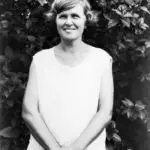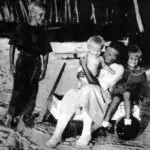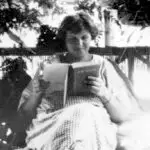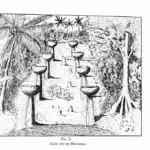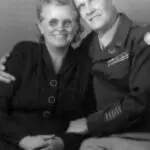Gertrude Costenoble Hornbostel
Trudis Alemån
Gertrude Costenoble Hornbostel (1893 – 1982) was born on 20 December 1893, in Reinfelden, Switzerland, to Gertrude Blum and Ludwig Wilhelm Herman Costenoble. In 1903 she and her older brother Hermann moved with their parents to settle in Saipan, which at the time was a territory of Germany.
Hornbostel’s father, Hermann L. Costenoble, was the head of the first German family to settle in the newly acquired German colony, the Mariana Islands. Northern Marianas German Governor Georg Fritz had invited Germans to immigrate to Saipan to increase farm production. The Costenobles arrived in March 1903 and settled near Talo’fo’fo, Saipan. The number of German residents remained minimal throughout the existence of the colony.
Initially friends with Fritz, disagreements soon developed between the governor and Hermann Costenoble, and in 1904, slightly more than a year after their arrival in Saipan, the Costenobles left the German Marianas and moved to American Guam.
In 1910 Hermann Costenoble became “Chief Forrester” of Guam and a prosperous farmer, in addition to opening stores in Hagåtña, Piti, and Sumai. Gertrude Hornbostel’s mother, also named Gertrude, taught school for many years, teaching music and other subjects in primary school. Mrs. Costenoble went back to Germany to pick up the remaining Costenoble children Hertha, Hilde, Herbert, Erich, and Willie, landing in New York from Bremen on 10 August 1907. The family continued across the United States by train, then boarded a ship sailing for Guam from San Francisco. On the ship, Mrs. Costenoble brought two beehives which were kept on the fantail of the ship, according to the Captain’s orders. One of the hives, however, was lost in a storm, but the other survived to offload in Guam.
Young Gertrude Costenoble grew up in Guam from age 11 to adulthood, where she learned to speak fluent CHamoru. She became known to CHamorus as “Trudis Alemån” – Trudis being a nickname commonly used for “Gertrudes,” and “Alemån,” the Spanish-adopted word meaning “German.” In some of her writings she referred to herself by this name. Her letters also make note that other CHamorus said she spoke the language like a native.Throughout her life, she used this linguistic knowledge and her first-hand cultural experiences to document and explain many facets of CHamoru life.
In 1914, Guam was a neutral oasis surrounded by European countries and Japan at war with Germany. The American military government suspected that Hermann Costenoble was a German intelligence agent. A young corporal in Guam’s newly-formed Insular Patrol, German-speaking Hans George Hornbostel, was assigned to determine if Hermann Costenoble was a spy as suspected. In the course of his duties he began dating young Gertrude, and they fell in love. Gertrude’s father refused Hans’ request for her hand in marriage, so the couple eloped, and were married in the General Baptist Church in Hagåtña under an archway of Cadeña de Amore (pink and white flowering vines), by Reverend A. W. Logan on 3 September 1914. Hornbostel had the unpleasant task of arresting his father-in-law, Hermann, on 27 March 1916 for beating Hermann’s son, Fritz. Hermann Costenoble left for the Philippines on 30 June 1916.
Gertrude and Hans Hornbostel spent the World War I years in the United States, where Hans served as a recruiting sergeant in San Francisco, Kansas City, and Tulsa, Oklahoma. Their son, Earl, was born in Guam in 1915, and a daughter, Gertrude, in San Francisco in 1918. Hans was again stationed in Guam, as a commissioned officer, in 1921. In 1922, Hans resigned from the Marine Corps as 2nd Lieutenant, and was hired by the Bernice P. Bishop Museum in Honolulu to collect artifacts from the Mariana Islands. He opened a Guam field office the same year. Their daughter, Johanna, was born in Guam in 1923.
Through Hans’ work as an anthropologist for the Bishop Museum, Gertrude was able to assist with translations from CHamoru informants and to provide insight into CHamoru culture that gave his work greater context and meaning. Her collections of stories, songs, verses, and notes on the Bishop Museum Hornbostel collection have contributed to the preservation of CHamoru heritage materials that otherwise would have been lost. She and her brother, Hermann, both worked as collaborators and assistants in this work. Gertrude also did a number of drawings of artifacts.
Professor Thomas Stolz and his associates from Bremen University, argue that Die Chamorro Sprache, written by Gertrude’s brother Hermann, relies primarily on sample texts collected by Gertrude. In fact, Hermann Costenoble tells his readers that his German CHamoru grammar book was augmented with sample texts drawn from the anthology of texts collected by his sister and his brother-in-law, Gertrude and Hans Hornbostel, in the 1920s. In particular, he specifies that, for the syntax chapter, he has used some of the texts published by Laura Thompson in 1932 that were originally collected by Gertrude Hornbostel.
Overall, Die Chamoro Sprache is a thorough in-depth study of the language, covering a wide range of areas. In this respect it surpasses all previous, more or less sketchy descriptions of the CHamoru language. Further, unlike many of his predecessors, Hermann Costenoble goes to the trouble of explaining his analyses and ideas and supporting them with arguments, most of which are linguistically sound. This is what makes Die Chamoro Sprache the very first truly linguistic description of CHamoru. Indeed, Gertrude Hornbostel’s intimate knowledge of the CHamoru language undoubtedly contributed to the value of this book.
Gertrude Hornbostel’s texts have received the attention at the University of Bremen, Germany, through research and writing by Professor Thomas Stolz and his colleagues Christina Schneemann, Barbara Dewain, and Sandra Chung. Schneemann wrote an article in German that compares two texts by Hornbostel published in Laura Thompson’s Archaeology of the Mariana Islands and in Hermann Costenoble’s Chamorro Grammar. Donald Topping included the Costenoble version in his Spoken Chamorro, and commented on its peculiarities.
Schneemann’s conclusion is that Gertrude Hornbostel’s original notes would be illuminating for the evaluation of the differing copies of her work. She also concludes that Hornbostel’s linguistic work deserves to be published. Colleague Barbara Dewein believes that Gertrude Hornbostel’s work has never got the attention it deserved, because officially, she was her husband’s assistant in the Bishop Museum work, and the notes and letters in the Hornbostel collection are generally associated with him.
Evidence of Gertrude Hornbostel’s wide range of knowledge is contained in the Hornbostel manuscript files at the Richard F. Flores Micronesian Area Research Center at the University of Guam. Handwritten notes and typed letters from Gertrude include information on uses of the coconut tree by native CHamorus, CHamoru names, details of the belembaotuyan musical instrument, legends, and translations of the call-and-response, verse-making song form called “Kantan Chamorita.” In fact, Gertrude Hornbostel translated more than 50 quatrains of verse sung by singers of Saipan in the 1920s.
When the Bishop Museum position ran out of funds in 1928, Hans, Gertrude and the Hornbostel family moved to Manila, Philippines, where Hans became the advertising manager for “Philippine Magazine.” He was working for the Coco Grove Mining Company in the Camarines Norte province when World War II broke out. He enlisted in the US Army at age 59, and was assigned to 302nd Regiment “Casey’s Dynamiters” as Captain, weighing 186 pounds. Gertrude, Johanna, Earl, and Gertrude Stewart’s family were taken as prisoners of war to Santo Tomas. Hans endured the Bataan Death March and subsequent imprisonment for the next three years.
In 1945 Hans and Gertrude were reunited. Hans weighed 98 lbs, Gertrude 105. Gertrude, Hans, and Johanna were sent to hospitals in the United States, where Gertrude was diagnosed with Hansen’s disease (leprosy) in 1946. She was sent for treatment to Carville, Louisiana, accompanied by her husband, who stayed with her at the hospital during the day and slept at a nearby farm. She was cured and released in 1949. She and Hans bought a house in North Belmore, New York, where they lived until Hans’ death in 1957.
Throughout the rest of her life, Gertrude Hornbostel continued to correspond with friends in Guam and elsewhere, and to travel and live in the Philippines and Singapore. She died in Manila, Philippines on 30 November 1982, and is buried at Arlington National Cemetery, Washington, DC.
For further reading
Airriess, Andy. “Name: airriess_family – Airriess Family Tree.” Last modified 26 September 2019.
Costenoble, Hermann. “Chamorro Language Notes.” Parts I-III. The Guam Recorder 12, no. 143 (1934): 303 and 319; 13, no 1 (1934): 22-23.
Farrell, Don A. History of the Northern Mariana Islands. Saipan: Commonwealth of the Northern Mariana Islands Public School System, 1991.
–––. The Pictorial History of Guam: The Americanization 1898-1918. 2nd ed. Tamuning: Micronesian Productions, 1986.
Hornbostel manuscript files, Boxes 1 and 2. Richard F. Taitano Micronesian Area Research Center, University of Guam.
Hornbostel, Gertrude C. “Chamorro Names.” The Guam Recorder 1, no. 3 (1934): 16.
Hornbostel, Hans, and Gertrude C. Hornbostel. Papers of archaeological notes and Chamorro language transcripts, 1924. Microfilm 261. Bishop Museum, Honolulu.
Rogers, Robert. Destiny’s Landfall: A History of Guam. Honolulu: University of Hawai’i Press, 1995.
Stolz, Thomas, Christina Schneemann, Barbara Dewein, and Sandra Chung. “The mysterious H. Who was the author of Die Chamoro Sprache?” In Philippine and Chamorro Linguistics Before the Advent of Structuralism. Edited by Lawrence A. Reid, Emilio Ridruejo, and Thomas Stolz. Berlin: Akademie Verlag, 2011.
Thompson, Laura M. Archaeology of the Mariana Islands. Bernice P. Bishop Museum Bulletin, No. 100. Honolulu: Bishop Museum Press, 1932.

